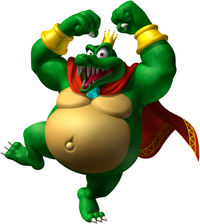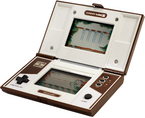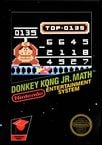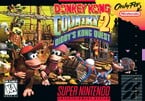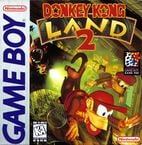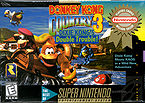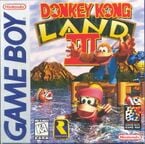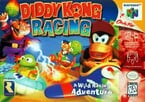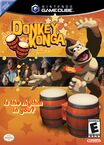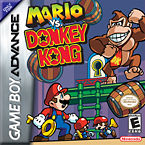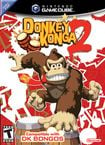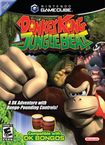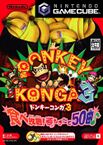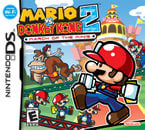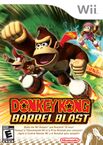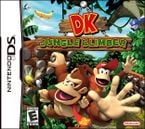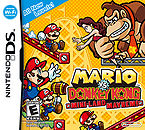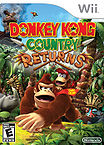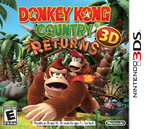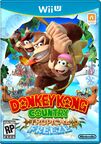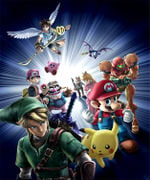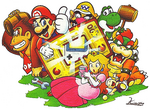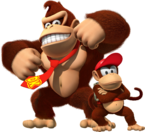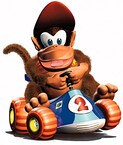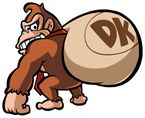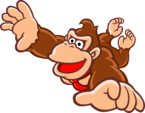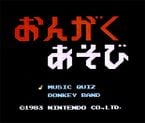Donkey Kong (series)
This article is under construction. Therefore, please excuse its informal appearance while it is being worked on. We hope to have it completed as soon as possible.
Template:Articleabout Template:Series-infobox
Donkey Kong (ドンキーコング Donkī Kongu) is a video game series that follows the adventures of an anthropomorphic gorilla named Donkey Kong and his various friends. Created in 1981 by famed Nintendo game designer Shigeru Miyamoto, it mainly consists of platform games and action puzzle games, but has branched out into other genres, including rhythm games, racing games, and edutainment.
The games of the first generation are single-screen platform/action puzzle games, where Donkey Kong features as the opponent in an industrial construction setting. The first game in the series, the 1981 arcade machine Donkey Kong, not only introduced the title character but also his rival Mario. After four years of success on arcades and in the "Game & Watch" handheld line, the series was brought to an end as Mario went on to star in Super Mario Bros., for which he is much better known, and take his place as Nintendo's flagship character. Donkey Kong was put on hiatus until 1994, when Rare, Ltd. revived the property with its side-scrolling platform game Donkey Kong Country. That game and its follow-ups focus on the adventures of Donkey Kong and the various members of his clan as they work to defend their native jungle setting from a variety of other anthropomorphic-animal characters who serve as villains. They are most frequently antagonized by the Kremlings, a race of crocodiles, and their leader King K. Rool. A hallmark of this series is the barrels used by the Kongs as weapons, vehicles, furniture, and lodging.
The Donkey Kong character is highly recognizable and popular, and the games have sold over 40 million units worldwide.[1]
Characters
The main character Donkey Kong, a muscular and somewhat dim-witted ape, first appeared in the eponymous arcade game in 1981 as the antagonist. In the later generations of the series, he became the main protagonist, and the defender of his carefree jungle home and his various primate friends. In the arcade game Donkey Kong Jr., he was given a son, also named Donkey Kong Jr., who had to save his father from Mario in that character's only appearance as a villain.
When the Donkey Kong property was revived for Donkey Kong Country, the original Donkey Kong character was reworked into a new character named Cranky Kong, an elder who constantly rambles and berates the younger generation of heroes. Cranky has been called the modern DK's grandfather by some sources, and his father by others. In his debut appearances, Cranky gave out randomly selected advice to the heroes on items and locations found within the game. In later games, he appeared as a potion-making chemist who granted special abilities to the heroes, and eventually as a fully playable character.
Diddy Kong is the modern DK's travel companion and best friend, nicknamed by him as his "little buddy." He was first introduced in Donkey Kong Country and then reappeared in its sequel. In many of his appearances, Diddy helps DK keep his island safe from whatever villain threatens to destroy it. In the Donkey Kong Country sequels, he gained a girlfriend, Dixie Kong, who is capable of flying in the air with her hair. Donkey Kong Country 3 gave Dixie a sidekick, Kiddy Kong, believed to be her cousin, who despite being a toddler has amazing strength that rivals even Donkey Kong himself.
A number of other members have been added to the Kong clan as the series has progressed, taking on both playable and non-playable roles. Funky Kong, one of DK's longest-standing friends and allies, often aids the Kongs through such means as selling and operating flight services. DK's love interest, Candy Kong, also helps him through various means, including running a music shop. In Donkey Kong Country 2, Cranky gained a wife, Wrinkly Kong, who managed her own school; by Donkey Kong 64, she was revealed to be deceased, and all her appearances after that game portray her as a ghost. Donkey Kong 64 introduced three new playable Kongs: Tiny Kong, a nimble and fast girl who is believed to be Dixie's younger sister, but in her later appearances has been redesigned to be taller than she; Lanky Kong, the joker of the clan, who despite his bizarre appearance and personality proves to be a capable fighter with his abnormal physique and lengthy arms; and Chunky Kong, Kiddy's older brother, who is physically the strongest and largest Kong in the family. Not all friendly characters in the series are Kongs, however; DK and his friends are sometimes helped by other anthropomorphic-animal characters, the most recurring being Rambi the Rhino and Squawks the Parrot.
The main antagonist of the Donkey Kong series is King K. Rool, the malevolent ruler of a race of crocodiles called the Kremlings, who has repeatedly attempted to disrupt the peace of Donkey Kong Island by means ranging from stealing the island's banana hoard to kidnapping some of the Kongs themselves. He, however, is not the only villain in the series. In Diddy Kong Racing, Diddy and his friends must confront Wizpig, a gigantic alien pig who loves to race those who challenge him, causing all sorts of chaos in the process. In Donkey Kong Jungle Beat, DK has to face a few evil Kong characters exclusive to the game, and their leader, Ghastly King. Donkey Kong Country Returns puts the Kongs up against the Tiki Tak Tribe, a race of floating wooden tiki masks which make music that has the power to hypnotize. In Tropical Freeze, DK and his clan face the Snowmads, an army of stereotypical Viking-themed arctic and antarctic animals, who seize the territory they invade by summoning a massive wind that throws the affected area into a state of perpetual winter.
Basic gameplay
The arcade games have simple gameplay where the player moves along the playfield, avoiding obstacles and enemies. In the original Donkey Kong, the playfield is a series of girders on a construction site, and the obstacles are barrels thrown by Donkey Kong.
In the side-scrolling games of the Donkey Kong Country series, players venture through uniquely themed levels and undertake varying tasks such as swimming, riding in mine carts, launching out of barrel cannons, or swinging from vine to vine. Most enemies can be defeated by a roll, jump, or ground slam which can also reveal secret items. However, some enemies that are more difficult to defeat will require the use of a barrel or the help of an animal friend. Throughout the levels are scattered several types of items that can be helpful to players and grant them additional lives, such as bananas which award an extra life if 100 are collected in a single play; Extra Life Balloons; and four golden letters that spell out K–O–N–G, which depending on the game can add to the player's life count or unlock a bonus or hidden level.
Games
1981-1989
| Title, original release and system | Description |
|---|---|
| Donkey Kong
|
In 1981, Nintendo had their first blockbuster release with Shigeru Miyamoto's creation - Donkey Kong. Originally released in the arcades, Donkey Kong became a very popular game amongst gamers, eventually spawning many remakes and ports. In this game, Donkey Kong was the antagonist who kidnapped "Jumpman's" girlfriend (Pauline). It was later ported to the many home systems including the Atari 2600, the Collecovison and the Nintendo Entertainment System. This is a simple platformer, where the player must control Mario while jumping and avoiding obstacles and making it to Donkey Kong. |
| Template:ReleasedateArcade Machine | |
| Donkey Kong Jr.
|
The following year, another arcade game was created, Donkey Kong Jr.. This time, the roles were reversed. Mario was the villain, and DK was a damsel in distress. Here, Donkey Kong Jr., Donkey Kong's son, had to save his kidnapped father from Mario. The gameplay is the same as the original Donkey Kong; Donkey Kong Jr. must avoid traps set off by Mario to save Donkey Kong by jumping and simply avoiding them. |
| Template:ReleasedateArcade Machine | |
| Donkey Kong II
|
Donkey Kong II was a Game & Watch game that was very similar to Donkey Kong Jr. It was based on the third and fourth levels of Donkey Kong Jr. and had the same plotline, but Mario was absent. Its gameplay involved Donkey Kong Jr. unlocking several chains to free Donkey Kong. |
| Template:Releasedate Game & Watch | |
| Donkey Kong 3
|
Donkey Kong 3 was the third installment of the Donkey Kong series, where Stanley fought DK. This game differed from its predecessors in that it is a shooter/platformer hybrid and did not include Mario as a character. |
| Template:ReleasedateArcade Machine | |
| Donkey Kong Jr. Math
|
Donkey Kong Jr. Math was Donkey Kong Jr.'s second game released in 1983 for the NES. Donkey Kong will hold up a sign, and Donkey Kong Jr. must find the numbers and math sign to get to that number to get a point. |
| Template:ReleasedateNES | |
| Donkey Kong Circus
|
Donkey Kong Circus is a Game & Watch title released as part of the Panorama series. Donkey Kong has been captured by Mario from his home and forced to put on a circus show to entertain the masses. |
| Template:ReleasedateGame & Watch | |
| Donkey Kong Hockey
|
Donkey Kong Hockey is one of the few two-player Game & Watch games ever manufactured. Donkey Kong and Mario must engage each other in a two-player game of Ice Hockey. |
| Template:ReleasedateGame & Watch |
1990-2000
| Title, original release and system | Description |
|---|---|
| Donkey Kong (Game Boy)
|
Donkey Kong (also known as Game Boy Donkey Kong and Donkey Kong '94) is the first Donkey Kong Game Boy Game in the series. This game is based on the original Donkey Kong but is made longer. |
| Template:ReleasedateGame Boy | |
| Donkey Kong Country
|
Donkey Kong Country is a game for the Super Nintendo Entertainment System. Released in 1994, it is known for being the first game to use pre-rendered sprites, creating a 3D effect throughout the game. It is the first game in the Donkey Kong Country series, with four sequels, Donkey Kong Country 2: Diddy's Kong Quest, Donkey Kong Country 3: Dixie Kong's Double Trouble!, Donkey Kong Country Returns and Donkey Kong Country: Tropical Freeze. It also has a similar semi-sequel, titled Donkey Kong Land. The game stars Donkey Kong, along with his buddy, Diddy Kong, in his debut, as the two travel across Donkey Kong Island in search for the Banana Hoard. The game was remade for the Game Boy Color in 2000, and was also remade again for the Game Boy Advance in 2003. The two remakes feature some new Bonus Games, the ability to save in the overworld, and several more new elements. Donkey Kong Country was also released on the Wii's Virtual Console in 2006, being the same as the original version. |
| Template:ReleasedateSNES | |
| Donkey Kong Land
|
Donkey Kong Land was the first installment of the Donkey Kong Land series, where is was a completely new and original follow-up to the game Donkey Kong Country. This is Cranky Kong's only time being an antagonist, because he was so jealous of Donkey Kong and Diddy Kong's success from the previous game, he told them he would never cut in on an 8-bit system (the system being the Game Boy (8-bit)), and told King K. Rool to steal bananas from the Banana Hoard. |
| Template:ReleasedateGame Boy | |
| Donkey Kong Country 2: Diddy's Kong Quest
|
Donkey Kong Country 2: Diddy's Kong Quest is the second Donkey Kong Country game for the Super Nintendo. It is the sequel of Donkey Kong Country and is also the predecessor to Donkey Kong Country 3: Dixie Kong's Double Trouble! and Donkey Kong Country Returns. The game has a Game Boy pseudo-sequel, Donkey Kong Land 2, that was released one year after the original. It was released in 1995 and stars Diddy Kong, as he and his partner, Dixie Kong, make their way through Crocodile Isle to save Donkey Kong from the Kremling Krew. In 2004, a remake of the game was made for the Game Boy Advance. It features several differences, including the addition of photographs and extra DK Coins. Later in 2007, the game was remade on the Virtual Console to play on the Wii system. |
| Template:ReleasedateSNES | |
| Donkey Kong Land 2
|
Donkey Kong Land 2 is a video game developed by Rareware and published by Nintendo for the Game Boy. Released in September 1996, it is a sequel to Donkey Kong Land, a predecessor to Donkey Kong Land III, and the handheld follow-up of Donkey Kong Country 2: Diddy's Kong Quest. Like its predecessor, the game features a yellow cartridge and Super Game Boy special features, giving the game a special banana border when played on a Super Game Boy. |
| Template:ReleasedateGame Boy | |
| Donkey Kong Country 3: Dixie Kong's Double Trouble
|
Donkey Kong Country 3: Dixie Kong's Double Trouble! is the third game in the popular Donkey Kong Country game series. It is the sequel to Donkey Kong Country 2: Diddy's Kong Quest. It also has a semi-sequel for the Game Boy, Donkey Kong Land III, as well another sequel, Donkey Kong Country Returns, for the Wii. The game stars Dixie Kong and her little cousin, Kiddy Kong, as they travel through the numerous lands of the Northern Kremisphere in order to rescue Donkey Kong and Diddy Kong from the Kremling Krew and their new leader, KAOS. |
| Template:ReleasedateSNES | |
| Donkey Kong Land III
|
Donkey Kong Land III (or Donkey Kong Land 3) is a video game for the Game Boy released by Nintendo in 1997. Loosely based on the Super Nintendo game, Donkey Kong Country 3: Dixie Kong's Double Trouble!, it is the third and final entry in the Donkey Kong Land series. Like previous games in the series, it features enhancements for the Super Game Boy and is housed in a yellow cartridge. The original Game Boy game was never released in Japan, however, it was eventually ported to the Game Boy Color and released in Japan on January 28, 2000 as Donkey Kong GB: Dinky Kong & Dixie Kong. |
| Template:ReleasedateGame Boy | |
| Diddy Kong Racing
|
Diddy Kong Racing is a game for Nintendo 64. Like the Mario Kart series, Diddy Kong Racing is a racing game, but makes use of airplanes, hovercrafts, and cars; it is also the first game of the Diddy Kong Racing series. The game has a story mode, multiplayer modes, and a variety of characters (many from Rare series), such as Diddy Kong, Banjo, Tiptup, and Conker, but not Donkey Kong. The game was a success that earned it a Player's Choice title and a remake for the Nintendo DS. |
| Template:ReleasedateNintendo 64 | |
| Donkey Kong 64
|
Donkey Kong 64 was Donkey Kong's first debut into the 3D world. Here, he takes along other friends, Diddy Kong, Tiny Kong, Lanky Kong, and Chunky Kong. King K. Rool is trying to destroy the DK Isle. The 5 Kongs stop King K. Rool from doing so in this 3D platformer, and they also collect a ton of items to help them on their adventure. This game also features several minigames and even a multiplayer mode. |
| Template:ReleasedateNintendo 64 |
2001-present
| Title, original release and system | Description |
|---|---|
| Donkey Konga
|
Donkey Konga is a Donkey Kong game for the Nintendo GameCube. It is the first game to feature the Bongos. The game spawned two sequels Donkey Konga 2 and Donkey Konga 3: Tabehōdai! Haru Mogitate 50 Kyoku, the latter of which was released in Japan only. |
| Template:ReleasedateGameCube | |
| Mario vs. Donkey Kong
|
Mario vs. Donkey Kong is a game for the Game Boy Advance. The game brings back Mario and Donkey Kong's rivalry from the Mario series' first game, Donkey Kong. The game's sequels are Mario vs. Donkey Kong 2: March of the Minis for the Nintendo DS, Mario vs. Donkey Kong: Minis March Again! for Nintendo DSiWare, and Mario vs. Donkey Kong: Mini-Land Mayhem! for the Nintendo DS |
| Template:ReleasedateGame Boy Advance | |
| Donkey Konga 2
|
Donkey Konga 2 is a Donkey Kong game for the Nintendo GameCube. This game is the follow-up of Donkey Konga, and has a japanese sequel called Donkey Konga 3: Tabehōdai! Haru Mogitate 50 Kyoku. |
| Template:ReleasedateGameCube | |
| Donkey Kong Jungle Beat
|
Donkey Kong Jungle Beat is the first successful GameCube title starring Donkey Kong. This game uses DK Bongos to play, an innovative way to control the characters in the game and also a very simple way to play. This game was developed shortly after Rare left Nintendo, as they were bought out by Microsoft. As a result, no old characters from the previous Donkey Kong games returned. This game was later released on the Wii under the New Play Control! series. |
| Template:ReleasedateGameCube | |
| DK: King of Swing
|
DK: King of Swing was released, and it featured the return of King K. Rool and Cranky Kong. It is a puzzle game, similar to that of Clu Clu Land, but has a more "adventure" type feel. Donkey Kong and his friends must swing across boards of pegs, while accumulating items, to clear levels. |
| Template:ReleasedateGame Boy Advance | |
| Donkey Konga 3: Tabehōdai! Haru Mogitate 50 Kyoku
|
Donkey Konga 3: Tabehōdai! Haru Mogitate 50 Kyoku is the third musical video game of the Donkey Konga series for the Nintendo GameCube. To play it, the Players have to use the Gamecube controller extension in the form of bongo drums. A bit related to the Dance Dance Revolution: Mario Mix, players are expected to hit the drums with the beat of a song. There are fifty-seven songs to play, and six playable characters. Players are also expected to clap at parts of the beat. |
| Template:ReleasedateGameCube | |
| Donkey Kong: Jungle Fever
|
Donkey Kong: Jungle Fever is a Japan-only Donkey Kong arcade game made in 2005 and sequel to Donkey Kong: Jungle Beat. The game received another Japan-only arcade sequel titled Donkey Kong: Banana Kingdom. |
| Template:ReleasedateArcade | |
| Mario vs. Donkey Kong 2: March of the Minis
|
Mario vs. Donkey Kong 2: March of the Minis is a puzzle game and the sequel to Mario vs. Donkey Kong. The game is for the Nintendo DS, and is followed in the series by Mario vs. Donkey Kong: Minis March Again!. It was released on September 25, 2006. |
| Template:ReleasedateNintendo DS | |
| Donkey Kong: Banana Kingdom
|
Donkey Kong: Banana Kingdom is a Japan-only Donkey Kong game found in the arcade. It is a sequel to Donkey Kong: Jungle Beat and Donkey Kong: Jungle Fever. Not much information about this game is known, and its relation to the Banana Kingdom is unknown. It was developed by Capcom. It was released in Japan on November 16, 2006. |
| Template:ReleasedateArcade | |
| Diddy Kong Racing DS
|
Diddy Kong Racing DS the Nintendo DS version of Diddy Kong Racing. Diddy Kong Racing DS is Rare's first Nintendo DS game. It makes use of the Nintendo Wi-Fi Connection. |
| Template:ReleasedateNintendo DS | |
| Donkey Kong Barrel Blast
|
Donkey Kong Barrel Blast is a Donkey Kong racing game for the Wii. Instead of cars, players utilize rocket-powered bongos. The title was originally planned for the Nintendo GameCube for use with the DK Bongo Controller. The game incorporates Miis. |
| Template:ReleasedateWii | |
| DK: Jungle Climber
|
DK: Jungle Climber is the sequel to DK: King of Swing. Due to it being a direct sequel, it has many similarities regarding gamplay and controls: Donkey Kong and his friends swing in a board of pegs to clear a level. Players can also play with each other in wireless multiplayer. |
| Template:ReleasedateNintendo DS | |
| Mario vs. Donkey Kong: Minis March Again!
|
In 2009 a third Mario vs. Donkey Kong game was released; Mario vs. Donkey Kong: Minis March Again! Unlike the previous two games, this game was released on DSiWare instead of a normal handheld console. In this game Mario and Pauline open the Super Mini Mario World Theme Park. Donkey Kong causes trouble when he kidnaps Pauline after becoming enraged because he missed out on a ticket. After Mario uses the Mini Mario (toy)s to rescue Pauline, it turns out the whole thing was a test for the Mini Marios. This game also used Nintendo Wi-Fi Connection. |
| Template:Releasedate DSiWare | |
| Mario vs. Donkey Kong: Mini-Land Mayhem!
|
Mario vs. Donkey Kong: Mini-Land Mayhem! is a Nintendo DS game and the fourth in the Mario vs. Donkey Kong series. It is Wi-Fi compatible, using the same system as in Mario vs. Donkey Kong 2: March of the Minis, plus, challenges where players submit their levels, and other players rate them, is available. |
| Template:ReleasedateNintendo DS | |
| Donkey Kong Country Returns
|
Donkey Kong Country Returns is a side-scrolling 2.5D platform game developed by Retro Studios for the Wii. It was released on November 21 in North America, and is scheduled to be released on December 2 in Australia, December 3 in Europe, and December 9, 2010 in Japan. It includes Donkey Kong and Diddy Kong, who travel across the island to retrieve the Banana Hoard. It is the fourth game from the Super Nintendo game series, Donkey Kong Country. |
| Template:ReleasedateWii | |
| Donkey Kong Country Returns 3D
|
Donkey Kong Country Returns 3D is a Nintendo 3DS remake of the aforementioned Donkey Kong Country Returns for Wii. This game features additional content, which includes a New Mode (which adds a third heart to the life meter, and new items in Cranky Kong's Shop), and a new area (known as Cloud), featuring new levels. |
| Template:ReleasedateNintendo 3DS | |
| Donkey Kong Country: Tropical Freeze
|
Donkey Kong Country: Tropical Freeze is the fifth installment of the Donkey Kong Country series, and was developed by Retro Studios for Wii U. Donkey Kong, Diddy Kong, Dixie Kong, and Cranky Kong are playable characters (with Dixie Kong and Cranky Kong both having a similar role to Diddy Kong in Donkey Kong Country Returns). The game's main antagonists; the Snowmads, are based off stereotypical Vikings. |
| Template:ReleasedateWii U |
Other Series
Partner Series
| Emblem | Name | Summary | List of Main Games |
|---|---|---|---|
 |
Super Mario Series
|
The Super Mario series is a long-running video game series published by the popular gaming company, Nintendo. The Mario series has been running for more than a quarter of a century, and in its lifespan has released more than two hundred video games. The Mario series has been released on a large array of systems, including home consoles, handheld game systems, and even personal and Macintosh computers. Originally starting out with an 8-bit game, the Mario series has gone through many graphical changes throughout the years. The series has spawned numerous sub-series, including the Mario Kart and Mario Party series; it has also taken a large part in the story line to its partner series, Yoshi, Donkey Kong, and Wario. |
|
 |
Super Smash Bros. Series
|
With the release of Super Smash Bros. in 1999, Nintendo started the Super Smash Bros. series. Though the series was more of a crossover series for all of Nintendo's major series, it has featured seven different Mario characters: Mario, Luigi, Peach, Bowser, Dr. Mario, Rosalina, and Bowser Jr. Yoshi, Donkey Kong, Diddy Kong, and Wario have also appeared as playable characters, however they are shown to represent their own series. In the games, players would select whichever character they wanted, and would then fight against each other on a specific stage. Each character had different move-sets, clearly defining them from one another. Characters could also use items to harm other characters or help themselves in some way. The game was an all-out fight between some of Nintendo's most popular video game characters. |
|
 |
Game & Watch Series
|
The Game & Watch series is one of the oldest series of games Nintendo has made. The series lasted for eleven years, from 1980 to 1991. The Game & Watch series has had five installments, each of which are a compilation of games; some of the games have extremely simple concepts, (such as Ball, where the player must simply juggle), while others have more detailed gameplay, (such as Donkey Kong Jr. and Super Mario Bros.). The Game & Watch series has had a total of thirteen games that revolve around the Mario series in some way. |
|
Donkey Kong Sub-Series
| Artwork | Summary | List of Games |
|---|---|---|
| Donkey Kong Country Series
|
The Donkey Kong Country series is a video game sub-series of the Donkey Kong series. Although it usually stars Donkey Kong and his pal, Diddy Kong, Donkey Kong also ends up as a damsel in distress in some games. The series is a platformer-type; levels are shown in a sidescrolling perspective and the heroes must jump and avoid obstacles in order to clear levels. The series was started by Rare, Ltd., until they were bought by Microsoft. Remakes are included in the Game Boy Color and the Game Boy Advance. The series were later revived by Retro Studios and their game, Donkey Kong Country Returns. The Donkey Kong Country series also has well-received reviews and has greatly impacted future titles. |
|
| Donkey Kong Land Series
|
The Donkey Kong Land series is an 8-bit video-game sub-series in the Donkey Kong series, created by Rareware for the Game Boy systems. The series' three games star Donkey Kong, along with other members of the Kong clan, Diddy, Dixie, and Kiddy, who travel through numerous levels in order to defeat King K. Rool and his aliases. |
|
| Diddy Kong Racing Series
|
Diddy Kong Racing games have been produced since 1997 with Diddy Kong Racing for the Nintendo 64. It features Diddy Kong and an all-star cast competing in a racing game. It is very similar to the Mario Kart series but features only Donkey Kong characters. Since its first generation on the Nintendo 64, a long hiatus was caused by Rare's buy-out by Microsoft, and two DKR games that had been in production had to be cancelled. In 2007, a remake of Diddy Kong Racing was eventually released on the Nintendo DS. |
Canceled Games
|
| Donkey Konga Series
|
Donkey Konga games have been being made since 2003 when Donkey Konga was released. All three installments include bongos which are also compatible with Donkey Kong Jungle Beat. It mostly features Donkey Kong and Diddy Kong but Dixie Kong and even Ellie the elephant have appeared in the series. All three installments are made only for the GameCube. The latest release was in 2005 with Donkey Konga 3: Tabehōdai! Haru Mogitate 50 Kyoku, released only in Japan. |
|
| Mario vs. Donkey Kong Series
|
Mario vs. Donkey Kong is a series of four games so far, consisting of modernized retailings of the original Donkey Kong game. They feature a comeback of Pauline, and Donkey Kong Vs. Mario rivalry. |
|
| DK Series
|
The DK series, consists of 4 games. Two of them are Japan-only games for the Arcade system. The first production in America is DK: King of Swing for the Game Boy Advance. The latest installment is DK: Jungle Climber. |
Cancelled Games, Tech Demos and miscellany
| Title | Summary | Planned system |
|---|---|---|
| Return of Donkey Kong | Return of Donkey Kong was the name of a title announced in the 1987 Official Nintendo Player's Guide. It is thought to either be a working title for Donkey Kong Classics or was meant to be a sequel to the 1981 Donkey Kong. | |
| Donkey Kong no Ongaku Asobi
|
Donkey Kong no Ongaku Asobi was a scrapped game meant for release on the Nintendo Entertainment System. The game was to be similar to Donkey Kong Jr. Math as an educational title meant to teach players music. | |
| Diddy Kong Pilot
|
Diddy Kong Pilot was the planned sequel to Diddy Kong Racing, but instead focusing only on flight. Due to Nintendo finding the game subpar and not wanting to publish it, and Rare being acquired by Microsoft shortly after, all Donkey Kong references were removed and the game was overhauled as Banjo-Pilot. | |
| Donkey Kong Racing
|
Donkey Kong Racing is another cancelled racing game, this one focusing on Donkey Kong instead of Diddy Kong. It would feature new versions of the Animal Friends such as a gigantic Rambi and a purple Enguarde. After the buyout of Rare, the game was converted into Sabreman Stampede for the Xbox 360; this iteration of the video game, however, also ended up being cancelled. | |
| Donkey Kong Coconut Crackers
|
Donkey Kong Coconut Crackers was a puzzle game developed by Rare. The company was bought by Microsoft before completing it, leading to the game being reworked as It's Mr. Pants. | |
| Donkey Kong Advance
|
The Nintendo DS NTR Debug Cartridge includes two graphics with the name "Donkey Kong Advance". It is currently unknown what the name was used for. | |
| Donkey Kong Country 4 | According to Rare employee Paul Rahme, it was internally suggested at Rare to make a Donkey Kong Country sequel on the Nintendo DS, as porting the trilogy to the Game Boy Advance gave the developers experience and a good basis for making a sequel.[2][3]. However, the proposal was turned down in favor of making Diddy Kong Racing DS. |
